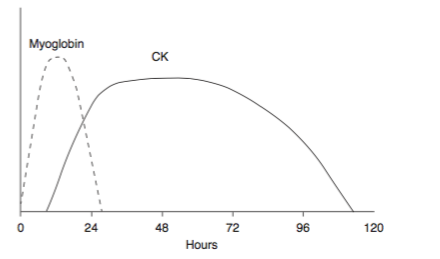Thyroid hormone exists in two forms: thyroxine and triiodothyronine. The ratio of thyroxine to triiodothyronine released in the blood is about 20:1 and peripherally, thyroxine is converted to
the active triiodothyronine (T3), which is three to four times more potent
than thyroxine.
Basic Terminologies
Basic Terminologies
- Primary hyperthyroidism is caused by the excess production of thyroid hormones from the thyroid glands.
- Secondary hyperthyroidism is caused by the excess production of thyroid-releasing hormones (Hypothalamus) or thyroid-stimulating hormones (Pituitary).
- Hyperthyroidism refers to excess circulating hormone resulting only from thyroid gland hyper function. Most commonly cause by Graves' Disease.
- Thyrotoxicosis refers to excess circulating thyroid hormone originating from any cause.
- Thyroid storm is an extreme manifestation of thyrotoxicosis. It presents as an acute life-threatening hypermetabolic state caused either by excessive release of thyroid hormones or due to altered peripheral response to thyroid hormone following a precipitating event.
Causes of Hyperthyroidism
- Graves' Disease
- Toxic Goitre
- Thyroiditis (Viral, Radiation)
- Hashimoto's
- Secondary (Pituitary or Hypothalamus related)
- Thyrotoxicosis Factitia
- Drug Induced (Amiodarone, Interleukin 2)
- Metastatic (Struma Ovarii)
- Hydatidiform Mole
Precipitants of Thyroid Storm
- Trauma
- Heat related Illness
- Recreational Drug Use
- Psychosis
- Stress
- Infection
- Iodinated Contrasts
- ACS
- DKA/HHS
- Thyroxine Overdose
Consider thyroid Strom in any patient presenting with fear, tachycardia and altered mental status. Use Burch-Wartofsky scale to gauge your suspicion and diagnosis.
Management
Following the order of treatment is of utmost importance here. Inhibition of thyroid
gland synthesis of new thyroid hormone with a thionamide (Methimazole or PTU) must be
initiated before iodine therapy.
1. Supportive care
2. Inhibition of new hormone synthesis
Methimazole: 40 to 100 milligrams PO as loading
dose then 20 milligrams q4h
3. Inhibition of thyroid hormone release
4. Peripheral β-adrenergic receptor blockade
5. Preventing peripheral conversion of thyroxine to triiodothyronine
The peripheral conversion of thyroxine to triiodothyronine is blocked by propylthiouracil, propranolol, and glucocorticoid. Glucocorticoids are essential in treatment since blockade produced by propylthiouracil and propranolol is not significant. . Glucocorticoid also treat underlying relative adrenal insufficiency.
6. Find and treat the precipitation event (Sepsis, DKA, ACS)
7. Definitive Treatment - Radioactive Iodine or Surgery
Other potential considerations:
- ABC
- Cardiac Monitor and IV accsess.
- Fluids, Maintenance of Electrolytes and Glucose. Cooling for hyperthermia.
- Add antibiotics as infection is a known precipitant and hard to distinguish in ED
- Consider Cholestyramine to decrease the reabsorption of thyroid hormone from the enterohepatic circulation. In thyrotoxicosis, there is increased enterohepatic circulation of thyroid hormone.
Thionamides: Methimazole or PropylThioUracil. Thionamides decrease the synthesis of new hormone production.
Propylthiouracil: Load with 600 to 1000 mg PO followed by 200 to 250 milligrams
every 4 hours. PTU is hepatotoxic but in addition to decreasing the synthesis of new hormone production, it also blocks the peripheral conversion of thyroxine to triiodothyronine.
Use PTU in first trimester and Methimazole in second and third trimester.
Potassium iodide can be given to stop thyroid hormone release. PTU or Methimazole must be started first and Iodine therapy should be given at
least 1 hour later. Iodine therapy blocks the release of pressured hormone. Start with 8 to 10 drops initially.
Iodine-containing solutions should not be given to
patients with iodine overload or iodine-induced hyperthyroidism or amiodarone-induced thyrotoxicosis. Lithium or potassium
perchlorate should be used instead.
Propranolol can be given IV in slow 1- to 2-milligram boluses q5-10min. Orally, propranolol therapy usually begins at 20 to 120 milligrams
per dose.
The peripheral conversion of thyroxine to triiodothyronine is blocked by propylthiouracil, propranolol, and glucocorticoid. Glucocorticoids are essential in treatment since blockade produced by propylthiouracil and propranolol is not significant. . Glucocorticoid also treat underlying relative adrenal insufficiency.
6. Find and treat the precipitation event (Sepsis, DKA, ACS)
7. Definitive Treatment - Radioactive Iodine or Surgery
Other potential considerations:
- Direct removal of thyroid hormone with plasma exchange
- Use of Potassium Perchlorate in Amiodarone induced thyrotoxicosis: Potassium perchlorate interferes with the production of new hormones
- Lithium: Used in cases of hypersensitivity to iodine. Lithium inhibits thyroid hormone release from thyroid gland. Typical dosing in thyroid storm is 300 milligrams every 8 hours. Monitor levels to avoid toxicity.
- Peripheral beta blockade: Reserpine or Guanethidine can be used, if there is a contraindication for BB use. These agents do not block beta receptors and interfere with catecholamine function (by depleting stores and blocking release)
Take Home:
- Consider Thyroid Strom in any patient presenting with fever, tachycardia and Altered Mental Status.
- PTU or Methimazole must be started first and Iodine therapy should be given at least 1 hour later.
- Manage with beta blockers, PTU/Methimazole, Steroids and Potassium iodide
- Identify and treat the precipitation cause
Further Reading
Posted by:
Lakshay Chanana
Speciality Doctor
Northwick Park Hospital
Department of Emergency Medicine
England








